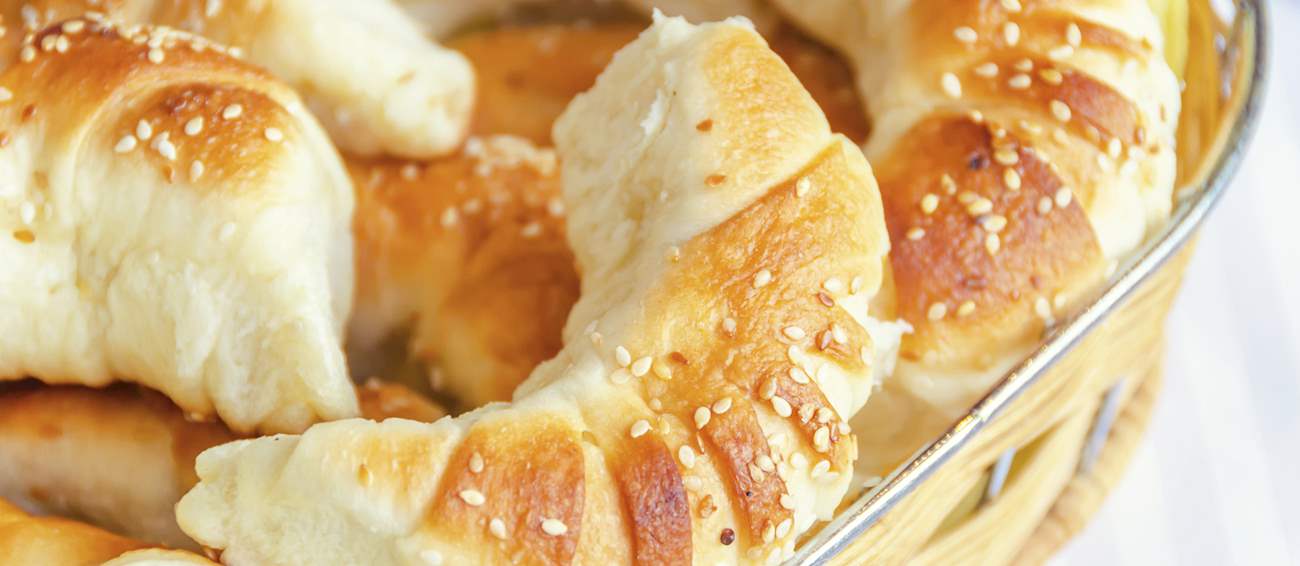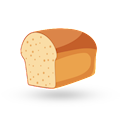MAIN INGREDIENTS
This traditional Hungarian dish is a savory version of the popular French toast. It can be prepared with various types of sliced bread that are coated in lightly beaten eggs, then shortly pan-fried until crispy. The dish is typically enjoyed as breakfast or a light evening snack and is often accompanied by creamy condiments such as mayonnaise and sour cream.
MAIN INGREDIENTS
Kifli are crescent-shaped yeast rolls that can either be consumed plain, sprinkled with poppy, sesame, or caraway seeds, or topped with fruit jam or honey. Although not much is known about the origin of kifli, there is a legend saying that kifli were invented when Christians defended Buda from the Ottomans, and as a sign of celebration, the city bakers started selling fresh bread rolls in the shape of a crescent moon.
Today, kifli are traditionally baked for Christmas in Hungary, and although there are many varieties of kifli throughout Europe, such as vanilias kifli and makos kifli, none of them are the same as the original crescent-shaped bread rolls.
MAIN INGREDIENTS
Lángos is a Hungarian specialty made by deep-frying a basic dough consisting of water, flour, yeast, sugar, and salt until it develops a golden-brown color. Sour cream, milk, or yogurt can all be used instead of water. Lángos is traditionally consumed fresh and warm as a snack, and it can be topped with anything from sour cream and grated cheese to garlic sauce and salt, although it is often consumed plain, as it is.
The name of the dish comes from the word láng, meaning flame, since it was originally baked near the flames of a brick oven, unlike today, when it is regularly deep-fried in oil. Some believe that lángos was created under Turkish influence, while others believe it comes from the ancient Romans.
VARIATIONS OF Lángos
MOST ICONIC Lángos
View morePogácsa is a popular Hungarian snack consisting of a small, bite-sized pastry that can be either sweet or savory. Preferably, it should be eaten while still hot. Although there are differences in size and flavor, all pogácsa pastries are commonly prepared in a round shape.
Their diameter may vary from that of a thimble to that of a drinking tumbler. There are numerous varieties of pogácsa - cheese, cabbage, potatoes, bacon, and pumpkin seeds, to name a few. In Hungarian folk tales, the main hero always takes a pogácsa baked in embers as food for his adventures and long journeys, which is a strong testament to the Hungarians' love for these traditional snacks.
MAIN INGREDIENTS
This Hungarian tube-shaped pastry popularly known as chimney cake traces its origin to the medieval era Székely Land—back then a part of the Kingdom of Hungary. The first known recipe titled Kürtős kaláts’ à la Mrs Poráni was found in a 1784 cookbook written by Transylvanian countess Mária Mikes de Zabola.
The pastry shells are made from sweet yeast dough that is rolled in granulated sugar, basted in melted butter, and spit-roasted over charcoal. Freshly baked, kürtőskalács shells can be topped with additional ingredients such as ground walnuts or powdered cinnamon, but they're also often filled with ice cream or whipped cream.
MAIN INGREDIENTS
Tepertős pogácsa owes its name to the tepertő, or pork crackling, the fatty remains of fried bacon which give this product its unique flavor and texture. Pogácsa is a small, cylindrical, baked pastry containing pork crackling and pork fat.
It is reddish-brown in colour and has a flaky, layered texture with pork crackling bits dispersed throughout its body. It is seasoned with salt and pepper. The dough is made with wheat flour, eggs, milk, yeast, sour cream, and either wine or vinegar.
Hailing from Sopron, babos pogácsa or babpogácsa is a variety of Hungarian pogácsa, a small, round, savory pastry with beans incorporated in the dough. This pogácsa is typically made with a combination of flour, cooked and mashed beans, lard or another type of fat (such as butter or margarine), sour cream, eggs, baking powder, salt, and pepper.
The dough is usually shaped into round portions, which are then brushed with egg yolks and (optionally) sprinkled with grated cheese, sesame seeds, or sunflower seeds before they’re baked until golden brown. The pastries are also commonly studded with a cooked bean in the top’s center before baking, while some versions call for decorating the pastry’s surface with a special pattern.
TasteAtlas food rankings are based on the ratings of the TasteAtlas audience, with a series of mechanisms that recognize real users and that ignore bot, nationalist or local patriotic ratings, and give additional value to the ratings of users that the system recognizes as knowledgeable. For the “Top 7 Hungarian Snacks” list until March 21, 2025, 1,144 ratings were recorded, of which 880 were recognized by the system as legitimate. TasteAtlas Rankings should not be seen as the final global conclusion about food. Their purpose is to promote excellent local foods, instill pride in traditional dishes, and arouse curiosity about dishes you haven’t tried.








